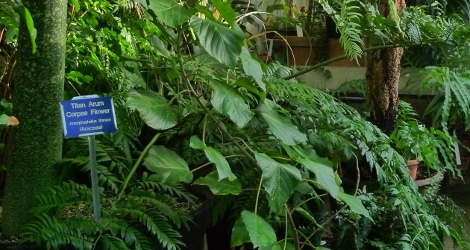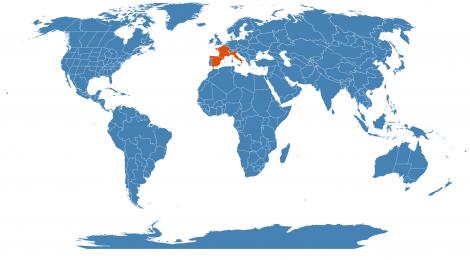Accession Data:
Lavandula angustifolia Mill.
- Common Name: Common Lavender, English Lavendar
- Family: Lamiaceae Lindl.
- Description: This dense, bushy subshrub is not native to England despite its English common name, but comes from the Mediterranean region of southern Europe. It grows to about 3 ft (1 m) tall though usually lower, with narrow, furry gray leaves. It is grown mainly for the long-stemmed heads of purple, scented flowers that appear in spring and through the warm months; these are easily dried for lavender sachets, potpourri and the like. It makes an attractive low hedge and can be trimmed after flowering.3
- Culture: Dry between watering, prefers neutral to alkaline soils.
- USDA Zone: 5
Accession Data:
- Accession # 198501273
- Source:
- Accession Date: 12-31-1985
- Bench: 2101 - MED:Mediterranean A
- Currently: active - healthy
- Qty: 2 confirmed on 05-06-2025
Classification:
- Division: Magnoliophyta
- Class: Magnoliopsida
- SubClass: euasterid I
- Order: Lamiales
- SubOrder:
- Family: Lamiaceae
- SubFamily: Nepetoideae
- Tribe: Ocimeae
- SubTribe: Lavandulinae
Flowering Data:
This accession has been observed in bloom on:| Year | Jan | Feb | Mar | Apr | May | Jun | Jul | Aug | Sep | Oct | Nov | Dec | ||||||||||||||||||||||||||||||||||||||||
|---|---|---|---|---|---|---|---|---|---|---|---|---|---|---|---|---|---|---|---|---|---|---|---|---|---|---|---|---|---|---|---|---|---|---|---|---|---|---|---|---|---|---|---|---|---|---|---|---|---|---|---|---|
| 2025 | ||||||||||||||||||||||||||||||||||||||||||||||||||||
| 2024 | ||||||||||||||||||||||||||||||||||||||||||||||||||||
| 2023 | ||||||||||||||||||||||||||||||||||||||||||||||||||||
| 2022 | ||||||||||||||||||||||||||||||||||||||||||||||||||||
| 2021 | ||||||||||||||||||||||||||||||||||||||||||||||||||||
| 2020 | ||||||||||||||||||||||||||||||||||||||||||||||||||||
| 2019 | ||||||||||||||||||||||||||||||||||||||||||||||||||||
| 2018 | ||||||||||||||||||||||||||||||||||||||||||||||||||||
| 2017 | ||||||||||||||||||||||||||||||||||||||||||||||||||||
| 2016 | ||||||||||||||||||||||||||||||||||||||||||||||||||||
| 2015 | ||||||||||||||||||||||||||||||||||||||||||||||||||||
| 2014 | ||||||||||||||||||||||||||||||||||||||||||||||||||||
| 2013 | ||||||||||||||||||||||||||||||||||||||||||||||||||||
| 2012 | ||||||||||||||||||||||||||||||||||||||||||||||||||||
| 2011 | ||||||||||||||||||||||||||||||||||||||||||||||||||||
| 2010 | ||||||||||||||||||||||||||||||||||||||||||||||||||||
| 2009 | ||||||||||||||||||||||||||||||||||||||||||||||||||||
| 2008 | ||||||||||||||||||||||||||||||||||||||||||||||||||||
| 2007 | ||||||||||||||||||||||||||||||||||||||||||||||||||||
| 2006 | ||||||||||||||||||||||||||||||||||||||||||||||||||||
| 2005 | ||||||||||||||||||||||||||||||||||||||||||||||||||||
References (internal):
References (external):
- The Plant List (2013). Version 1.1. Last accessed on Friday, January 06, 2017.
- WCSP (2016). World Checklist of Selected Plant Families. Facilitated by the Royal Botanic Gardens, Kew. Last accessed on Friday, January 06, 2017.
- Botanica, Turner & Wasson, 1997, CD-ROM Version
data regenerated on Sat, 24 May 2025 13:27:11 -0400 [bcm v4.0]
Images:

Additional images for this accession:
Click on thumbnails to enlargeCurrent Accessions in the Lamiaceae
Subfamily Ajugoideae
- Clerodendrum nutans


- Clerodendrum speciosissimum


- Clerodendrum thomsoniae


- Faradaya splendida

- Petraeovitex bambusetorum


- Teucrium chamaedrys

- Teucrium fruticans

Subfamily Lamioideae
Tribe Pogostemoneae
Subfamily Lamioideae
Tribe Stachydeae
Subfamily Nepetoideae
Tribe Mentheae
- Lycopinae: Lycopus europaeus

- Menthinae: Thymus kotschyanus

- Prunellinae: Prunella grandiflora

- Salviinae: Rosmarinus officinalis


- Salviinae: Salvia discolor

- Salviinae: Salvia microphylla


- Salviinae: Salvia officinalis


- Salviinae: Salvia pinguifolia


Subfamily Nepetoideae
Tribe Ocimeae
- Lavandulinae: Lavandula angustifolia


- Lavandulinae: Lavandula dentata

- Ociminae: Ocimum tenuiflorum


- Plectranthinae: Coleus scutellarioides

- Plectranthinae: Coleus scutellarioides

- Plectranthinae: Plectranthus amboinicus

- Plectranthinae: Plectranthus neochilus


- Plectranthinae: Plectranthus saccatus


- Plectranthinae: Tetradenia riparia

Subfamily Prostantheroideae
Tribe Westringieae
Subfamily Scutellarioideae
- Holmskioldia sanguinea


- Scutellaria alpina


- Scutellaria argentata


- Scutellaria javanica


- Scutellaria purpurascens subsp. verecunda W/C

- Scutellaria tuberosa W/C

Subfamily Symphorematoideae
Subfamily Viticoideae
W/C = Wild Collected = indicates flowering in past 14 days
= indicates flowering in past 14 days
 = images available for this accession
= images available for this accession
 = map available for this accession
= map available for this accession
 = accession added within past 90 days
= accession added within past 90 days

